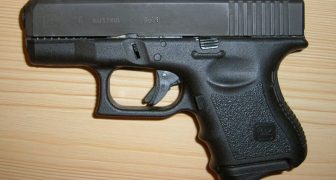This is a guest post by Andrew Betts
A bright, dependable flashlight is probably the most important piece of self-defense gear, behind a gun and a phone. It is far more important than an optic or magazine pouch and it’s definitely more important than the flavor of ammo in your magazine.
It’s easy for us to get wrapped around the axle about gear and ammo choices and lose sight of the fact that the most important factors are being able to fight, communicate, and, you know, see the bad guy. Now that the CREE LED is commonly produced for low cost in China, there are a great number of cheap lights on the market. Some are awful, some are great, and some are just mediocre. Let’s take a look at the Lumintop SD20.
First, let’s get the good points out of the way. This light is reasonably tough. It survived a camping trip on the Verde River, where it spent nearly as much time submerged in the river in my cargo pocket as it did out of the water. It got banged around quite a lot and it still runs. The trouble that I had with the switch in the video was due to low batteries. They had enough juice in them to power the light but the switch starts to get wonky when the power is low. That’s probably the first chink in the SD20’s armor, but we’re talking about its strengths. The other major positive is that the high mode is insanely, ludicrously bright for a small, handheld light.
Unfortunately, there are several low points for this sight as well. The most glaring problem for a defensive light is the location of the power switch and the method of operation. A defensive light needs to be easy and instinctual to operate. The preferred location for the switch is on the tail cap so that it is quickly located, no matter how the light is oriented. The switch on the SD20 is on the side. The preferred mode of operation is momentary. Many lights have the ability to stay on by pressing the switch harder for a positive “click”. I personally prefer this feature, but the momentary feature is absolutely necessary in a light that may be used for defense.
Another issue that may not be a deal breaker for you, but is certainly a big negative for me was the lack of pocket clip. The light did come with a belt case, but my personal preference is for a pocket clip. Finally, the light suffers from a serious case of feature creep. It is useful to have multiple modes in a working light and the retina searing high mode is really nice for camping, but a defense light only needs one brightness setting. Tim Allen style design philosophy is not ideal here, either.
For defensive use, you want a light that is bright enough to see clearly and disorient a bad guy but not so bright as to completely annihilate your own night vision. That means 100-200 lumens is probably best, depending on the focus of the beam. If a light also had a low power work mode to increase battery life, that would be a useful feature, so long as selecting that mode was done by means of another switch and didn’t interfere with the normal mode. For example, some lights accomplish this by rotating the bezel or tail cap.
Many of these features are common in lower end flashlights, but the biggest problem is that the SD20 retails for about $40. That’s actually not much cheaper than entry model lights from Surefire or Streamlight and substantially more than some lights with more practical feature sets. As always, your gear won’t win the fight. You will. Your training and will to fight are the factors which will most strongly influence your ability to survive.
Andrew Betts served with the Arizona National Guard for over 12 years, including a tour to Afghanistan. Visit his YouTube Channel for more great shooting information.


Speak Your Mind